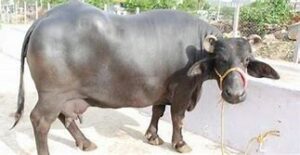ABORTION IN BOVINE
Dr.Tanya pawar, Dr.Tejasvi Meshram, Dr.Neelam Tandia, Dr.Priya Singh
Department of Veterinary Surgery and Radiology, College of Veterinary Science and Animal Husbandry Kuthuliya, Rewa (M.P.)
Nanaji Deshmukh Veterinary Science University Jabalpur (M.P.)
INTRODUCTION
The word abortion has a latin root- Ab = abnormal and oriri = to born. Abortion is expulsion of living or dead fetus of recognizable size before term. If death occur at 1-2 month of gestation, it is usually termed as early embryonic death in which embryo is usually resorbed by uterus with no external sign evident that pregnancy has terminated. After 2 months there is usually the expulsion of fetus and placenta. When fetus is near term and born dead it is called as stillbirth.


Image reference: Tradeindia Image reference: Indiamart
CAUSES OF ABORTION
- Non-infectious causes
- Infectious causes
- NON-INFECTIOUS CAUSES
Physical causes- abortion in cattle may be caused by trauma or accidental injuries like fall from height, prolonged struggling, fighting, and exposure to extreme climatic condition, vaccination, transportation, irregular feeding, and careless treatment during prepartum torsion of uterus, trauma during major operations in pregnant animals etc.
Toxic influences- poisoning due to chemicals like chlorinated naphthalene, lead, locoweeds, purgatives( castor oil, calomel, aloes), sodium iodide, selenium, ergot, carbon tetrachloride, phenothiazine, quinine, pyrophosphorus , digitalis, sweet clover hay or musty or mouldy silage.
Hormonal factors- estrogen pellets, diethyl stillboestrol, estrogen pellets, glucocorticosteroid administration may lead to abortion in various stages of pregnancy. Progesterone deficiency may cause early abortion between 45 to 185 days.
Nutritional deficiencies– deficiency of vitamin A causes eye defects and keratinization of vaginal epithelium and degeneration of placenta which may lead to abortion. Lack of calcium, selenium, iodine, cobalt, iron, and copper may also cause abortion.
Hereditary factors-mummification, achondroplasia, hydropic condition, anasarca, inbreeding causes embryonic deaths, abortion, and stillbirth.
Miscellaneous factors- repeated blood transfusion with incompatible blood, torsion of uterus, strangulation of uterus by lipoma and lack of caruncular area, anaphylactic reactions, and severe burn may lead to fetal death and abortion.
INFECTIOUS CAUSES
- Contagious abortion– are associated with bacterial diseases like brucellosis, leptospirosis, listeriosis, vibriosis, and salmonella abortus.
- Viral diseases– infectious bovine rhinotracheitis, infectious pustular vulvovaginitis, epizootic bovine abortion (EBA), bovine viral diarrhea, parainfluenza, blue tongue, coxiella or rickettsia burneti and Q-fever.
- Mycotic diseases– aspergillus fumigatus, candida tropicalis, mucorpusilla, rhizopus arrhizus, monosporium apiospermum etc.
- Protozoal diseases– Trichomonas fetus, toxoplasmosis,
- Miscellaneous disease– Tuberculosis, Corynebacterium pyogenes, pseudomonas aeruginosa, aeromonas hydrophila, streptococci, staphylococci, coliform bacilli, haemophilus, spherophorus necrophorus.
CLINICAL SYMPTOMS
Early abortion usually go un-noticed. Animal returns to service very early. In the second trimester animal may abort without any apparent symptoms. In some cases mild straining with tail elevated, peculiar bellowing, relaxation of diaphragm, pelvis and vulva, liquefaction of cervical seal and sero-sanguinous discharge at vulva noticed.
Other symptoms- protrusion of fetal membrane or water bag from vulva prior to expected date of calving, spontaneous expulsion of dead or live underdeveloped fetus of recognizable size, anorexia, dull depressed.
Stages of abortion-
- Early abortion (1-3 months) – caused by Trichomonas.
- Mid abortion (4-7 months)-caused by Campylobacter, Aspergillus and mucorale.
- Late abortion (6-9months)-caused by Brucella, Leptospira, Listeria and Epizootic bovine abortion.
- At any stage of gestation- Infectious bovine rhinotracheitis and Bovine viral diarrhea.
CONTROL AND PREVENTION OF ABORTION
- Due to multifactorial aetiology, general prevention of non-infectious abortion should focus on good husbandary, feeding and management.
- Control of infectious abortion is based on good disease control through closed herd policy, careful screening and quarantine of bought- in animals and good biosecurity.
- To prevent abortion due to IBR-IPV, vaccinate heifers at 6-8 months of age.
- To prevent abortion due to listeriosis, feeding of poor quality silage with high pH should be prevented.
- To prevent abortion due to brucellosis, vaccinate female calves at 6 months of age with strain 19 brucella vaccine.
- Breeding should be stopped at disease outbreak.
- Diseased bulls should not be used for breeding.
- Pregnant animal shed should not be slippery.
- Isolate the animal which have aborted.
- Proper disposal of aborted fetus and its membrane.
CONCLUSION
Abortion causes various economic losses to livestock industry because of loss of young one, loss in milk yield followed by infertility/sterility. The diversity of abortifacients makes abortion diagnostics a complex and challenging discipline that additionally is restrained by time and economy. Thus abortions in a herd can be best prevented by keeping proper herd records, carrying out timely vaccination, quarantine of newly added animals, careful screening and by practicing good management practices in a farm.

